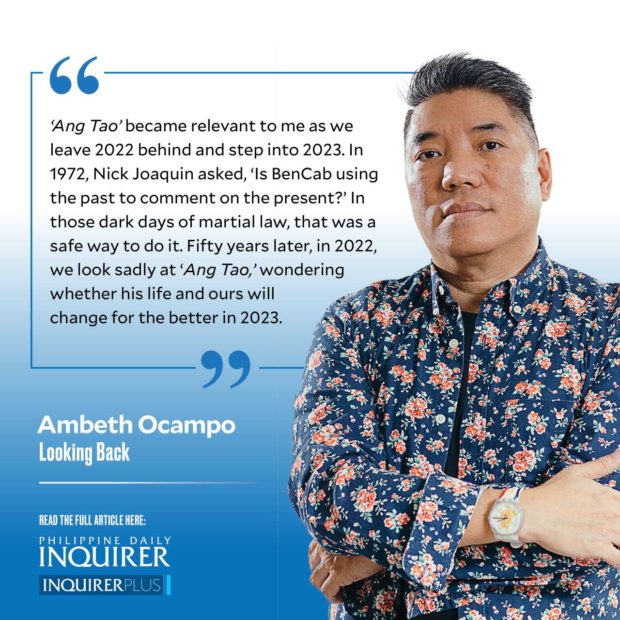‘Ang Tao’
For many people, the Cultural Center of the Philippines (CCP) is just a venue for the performing arts: a concert hall, a stage for dance and drama, and a screen for film, mainstream and indie. Outside of performances, the CCP has a library and an art gallery. For me, the iconic building designed by National Artist Leandro V. Locsin is more than a tour de force in architecture; it is a jewel box for national cultural treasures. CCP should have a museum to gather the many important works scattered throughout the complex. To name a few: Victorio Edades’ “The Builders,” Napoleon Abueva’s “Allegorical Harpoon,” Jose Joya’s “Dimension of Fear,” Fernando Amorsolo’s “Burning of the Intendencia,” Guillermo Tolentino’s “Madonna and Child.” I was fortunate to have encountered many of these works inaccessible to the public in the late 1980s while undertaking projects. One of my favorites is “Ang Tao” by National Artist BenCab.
Before I saw it in person, I only knew “Ang Tao” in sepia, from the Luz Gallery catalog of the artist’s landmark “Larawan” show in 1972. Unlike the other works in the show, “Ang Tao” was not even given a whole page in the catalog because of its configuration—it is oversized rectangular, rather than boring square. I imagined it to be small like many of BenCab’s early graphic works. Then, sometime after the 1986 People Power Revolution, I finally saw “Ang Tao” hanging in the office of Dr. Nicanor Tiongson, then CCP vice president and artistic director.
“Andito ka lang pala!” I said in my head as if I had bumped into a long-lost friend.
Surprised by its size, I exclaimed, “Ang laki mo pala!”
“Ang Tao” ornamented one end of the room; facing Tiongson’s desk, it dominated a sitting area and coffee table, where the old man could have been mistaken for a waiter. “Ang Tao” was not in sepia or black and white as I had imagined. It had color deftly applied to mimic stains on an archival photograph distressed and ravaged by time.
The image, painted in acrylic, on two separate sheets of paper was cut in half. Necessity forced BenCab to crop the image in two to work around the issue of paper size. Its result was serendipitous because it invites the viewer to process and appreciate the work differently.
If it were painted on one extraordinarily large sheet of paper, it would not have worked out so well. Looking at the old man cut in half at the waist, I associated it with a manananggal, but then the manananggal is a beautiful sexy maiden, not this stooped old man in wrinkled clothes holding a crumpled hat. BenCab’s “Ang Tao” is a shameless display of skill in drapery.
“Ang Tao” was so lifelike, it seemed he could walk out of the picture frame and step down on the sofa. I noted that he was barefoot and had splayed feet, a deformity presumably acquired from years of walking without footwear.
“Ang Tao” did not emanate from BenCab’s imagination; it is based on an old photograph. This has led to some ignorant comments on appropriation and criticism of BenCab’s “Larawan” as nothing more than tired images drawn out of an old baul. While it can be argued that many artists have the same skill that enables them to copy or appropriate an archival image, we can do a better job at that with a scanner or a smartphone. BenCab does not just copy; he filters images from the late 19th or early 20th century Philippines through his eyes, places the image in context by his readings and experience, then with the instinctive sense of design and exceptional craftsmanship that is both the backbone and power of his work, creates a representation of the past that speaks to the present.
Old images are not deployed for nostalgia. They are repurposed to evoke an interplay of past, present, and future. One could say that BenCab’s “Ang Tao” comes in different shapes and forms today, from a street urchin begging for loose change in the streets of Metro Manila, to a victim of extrajudicial killing mourned by friends and kin.
“Ang Tao” became relevant to me as we leave 2022 behind and step into 2023. In 1972, Nick Joaquin asked, “Is BenCab using the past to comment on the present?” In those dark days of martial law, that was a safe way to do it. Fifty years later, in 2022, we look sadly at “Ang Tao,” wondering whether his life and ours will change for the better in 2023.
——————
Comments are welcome at aocampo@ateneo.edu





















